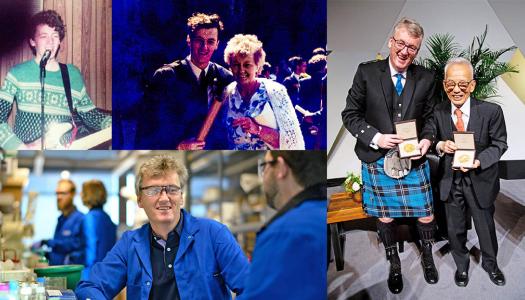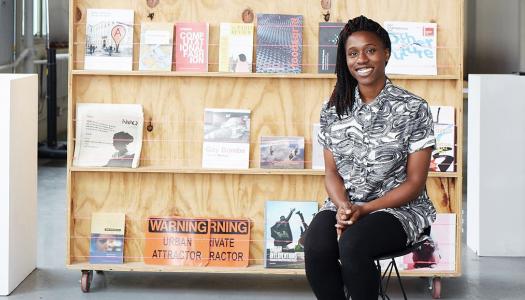Uncovering history’s hidden stories: Autumn Womack’s journey from grade-school history camp to Toni Morrison’s archives
Growing up in Philadelphia, Autumn Womack was a bit of a history nerd who immersed herself in books. In the summer after sixth grade, Womack attended a city-sponsored camp at the now-closed Atwater Kent Museum that sparked her curiosity for the objects, people and moments tied to the historical stories she loved. “Every week we would study a different era of Philadelphia history,” Womack said. “To help us relate, we were given an identity of an individual who lived during that time.”
Using the census records in the museum’s archives, each camper was encouraged to keep a journal as a person living in the city at that time. “We were being invited to think with archives,” she said. “We went where they lived and worked, retracing each of their individual lives by way of the census information.”
It was the first time Womack did archival research, and she was captivated by the ability of physical records to articulate a living history: “I began to see that there wasn’t just an imaginative world to these historical moments I was obsessed with, but also tangible material evidence of it.”
More importantly, she said, there was a different way to tell stories about the past using historical documents. Now, as an associate professor of English and African American studies who focuses on the 19th and early 20th centuries, Womack has honed her deep and longstanding interest in archival research to open up a world of deeper understanding. “I love the idea of material objects like photos, clothing and letters offering another life with a fuller account of a person, a historical moment or a book,” said Womack, who authored “The Matter of Black Living: The Aesthetic Experiment of Racial Data, 1880-1930” in 2022. “It’s not just about what’s on the page, but what’s behind it.”
Teaching Students to Dig Deeper
Womack recently finished teaching a survey class on the evolution of African American literature. The syllabus included the writings of Harriet Jacobs and Charles Chestnutt and a range of genres — poetry, novels, articles and plays — from the mid-18th to the early 20th centuries.
Despite the class being a core requirement for both African American studies and English majors, many of the 24 students were from other disciplines who took the class to fulfill a language arts requirement. No matter their concentration, Womack hopes all her students become inspired to see the world differently through the historical and literary figures they encounter in her class. “I had a student who’s a biochemistry major tell me that he doesn’t know how to read literature,” she said. “I told him, ‘You read cells, so you can certainly read writing.’” Rather than adapting the coursework to where the students are, she insists that they challenge themselves: “I’d be doing everyone a disservice if I don’t assume these students can do difficult things.”

Womack invites her students to think differently about the kinds of questions they ask about history. Her archival research assignments are designed to compel her students to think from the object out, which means teaching them to let the research tell the story as opposed to cherry picking the research to support their theories. “It’s a lot of unlearning, because that’s the way students learn how to write essays in high school — start with a thesis and find the evidence to prove it,” she said.
For instance, her class visits special collections, like the archives of 19th-century American publishers, and Womack asks the students about the questions each object — a photograph, newspaper clipping, book review, broadside poster or rare book — is raising. And she asks what questions is the object ignoring. It’s an assignment that Womack said consistently produces the best and most interesting papers from her students, even though many of them struggle with not imposing their own analysis immediately upon the object. “Letting the research guide you can be difficult and is not always intuitive,” Womack said. “It involves a different kind of curiosity that students don’t always get to exercise. And I think they feel proud of the work they end up doing as a result. I hope they carry this with them into other fields.”
Another course she regularly teaches, “Reading Toni Morrison,” leans heavily on archival research, specifically the Morrison Papers housed at the Princeton University Library. She started teaching the course in the spring of 2019, just a few years after the collection opened to the public. As part of the class, students conduct archival research using Morrison’s correspondence, manuscript drafts, outlines, notes, photographs and timelines for each of her novels. Students who take the class get to delve into how Morrison built her worlds, Womack said. “They can better understand how she steadily turned her ideas into these dynamic places that readers imagine themselves in, connecting with the humanity in her characters.”
Mining Morrison’s Memos and Marginalia
Last year, Womack used her archivist expertise to curate “Toni Morrison: Sites of Memory” in Firestone Library’s Milberg Gallery. The critically acclaimed exhibition of Morrison’s notes, novels and creative process commemorated the 30th anniversary of Morrison’s Nobel Prize in Literature. She began the project in 2020 at the request of the Princeton University Library. With the help of two graduate students and René Boatman, Morrison’s longtime assistant, Womack sifted through the 400 boxes of materials the author collected over her lifetime.
Morrison joined the faculty in 1989 as the Robert F. Goheen Professor in the Humanities, and for 17 years she taught courses in creative writing, African American studies, English and American studies. Morrison donated her archives to Princeton in 2014, and in 2017 Princeton dedicated Morrison Hall — currently home to the African American studies department — in her honor.
Womack compared the process of creating the exhibit to lifting up the hood on Morrison’s writing and showing the world how her creative engine worked. “We don’t often see that with a writer’s mind — we just think that a book arrives as a finished product,” Womack said. “We curated the exhibit according to the story the archive presented to us as we worked through the boxes. It was about craft and process and practice, telling the story about the way she tells stories.”
She loves to talk about the hand-drawn maps that Morrison created for all the characters living in Ruby, Oklahoma, the all-Black town at the center of her novel, “Paradise.” “Each character had a map from where they lived and moved that created a very real place where they might emerge and dwell,” Womack said. For her, these point-of-view diagrams were a familiar creative process. “As a kid, I mapped out similar worlds for my dolls and paper dolls to breathe more life into their interactions.”
Womack hopes those who experienced the exhibit walked away with a fresh perspective on the complexities of Morrison’s books. “It was very much in her spirit, being a story that’s difficult at times but one that compels the reader onward,” she said. “There’s a reward in that. Either you learn something about yourself or you learn something about the world or you learn something about her or the text or language.”
With the new insights she gained from curating the exhibit, Womack is now working on a book about Morrison’s creative process. “It was fascinating to see such an active thinker on the page, moving from idea to research to outline to draft back to outline,” she said. “Her process wasn’t always linear or surefooted. You can see that writing doesn’t move in a straight line from A to Z.”
One of the biggest surprises for Womack came from the ideas that Morrison developed, abandoned and never went back to. A good example, she says, is an outline from the archive in which Morrison envisions “Beloved” as an epic trilogy spanning the mid-19th century through the 1980s. “One of the many wonderful things about the Morrison Papers is that we have access to so many of the different drafts and outlines and research avenues that she went down for almost every one of her published novels,” she said. “There are all these other versions of a novel, the short story or speech we see living in the archive. She just decided that the other books in the trilogy were not plotlines she wanted to pursue.”
The Site of Memory
Given her new appreciation of Morrison’s creative process, Womack has a new favorite Morrison novel. “‘Paradise’ was the first book she wrote after winning the Nobel Prize and it’s weirdly different than anything she wrote before,” said Womack, who first read the 1998 book, about a Black town founded by former slaves who find themselves rejected both by white people and lighter-skinned Black people, when she was in graduate school. “You can see the work on the page, which is why I like it. You can see the craft happening. It’s so beautifully layered and so difficult. Every time I read it, I feel like I never read it before.”

Just as she did as a young girl in Philadelphia, Womack can still immerse herself in a book, especially during the summer when teaching classes and grading papers don’t interrupt her. And she occasionally finds herself thinking in the language of the book. “When a novel is good, it changes the rhythm of my thoughts,” she said, “and I’ll hear myself ordering coffee in my head in the syntax of the narrator.”
This notion of empathy via literature — seeing the world differently in the shoes of a character unlike oneself — lies at the heart of Womack’s research and teaching. “At its best, literature can change how you see the world, providing language that oftentimes you didn’t know you needed.” Womack said the highest goal for her students is for them to come away from her classes learning something new about themselves and thinking differently about the kinds of questions they ask about history. “That’s a high bar,” she said, laughing. “The bare minimum is I would like them to become more confident in their capacity to learn and write about what they read and what they see.”



